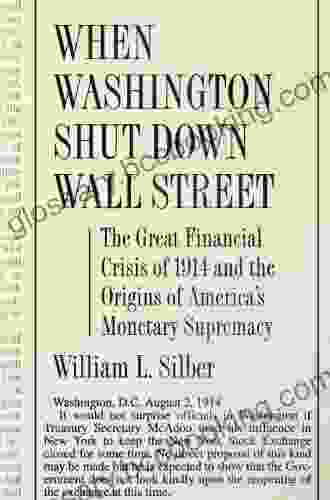When Washington Shut Down Wall Street: Uncovering the Truth Behind the 2008 Financial Crisis

In the aftermath of the catastrophic 2008 financial crisis, the world was left reeling from its devastating impact. The once-mighty Wall Street was brought to its knees, as the global economy teetered on the brink of collapse. In When Washington Shut Down Wall Street, investigative journalist and financial expert Steve Eisman delves deep into the events leading up to and following the crisis, unveiling the shocking truth behind the biggest economic meltdown in history.
Eisman begins his exposé by tracing the roots of the financial crisis to the subprime mortgage market. In the years leading up to the crash, banks and financial institutions had rampantly issued risky subprime mortgages to borrowers with poor credit histories and low incomes. These loans were packaged into complex financial instruments known as collateralized debt obligations (CDOs) and sold to investors around the world.
As housing prices continued to rise, the value of these CDOs soared. However, when the housing bubble burst in 2007, the value of these mortgages plummeted, triggering a chain reaction that spread throughout the financial system.
4.5 out of 5
| Language | : | English |
| File size | : | 4102 KB |
| Text-to-Speech | : | Enabled |
| Screen Reader | : | Supported |
| Enhanced typesetting | : | Enabled |
| Word Wise | : | Enabled |
| Print length | : | 210 pages |
Eisman meticulously documents the role Wall Street banks played in the subprime mortgage debacle. Driven by greed and reckless lending practices, they knowingly sold these risky mortgages to unsuspecting investors, profiting handsomely from the sale of these toxic assets. Moreover, they failed to adequately disclose the risks associated with these investments, leaving investors vulnerable to catastrophic losses.
Eisman argues that the government's complacency and lack of oversight contributed significantly to the crisis. Despite warnings from financial experts, regulators failed to rein in the reckless behavior of Wall Street and address the growing risks in the financial system.
The Bush administration's policies, such as the Housing and Economic Recovery Act of 2008, which encouraged risky lending, further exacerbated the situation.
In the face of the impending financial collapse, the government was forced to intervene with a series of unprecedented bailouts. The Troubled Asset Relief Program (TARP) poured billions of dollars into struggling financial institutions, while the Federal Reserve lowered interest rates to historic lows.
While these measures averted a complete economic meltdown, Eisman argues that they also bailed out the very institutions that had created the crisis. The lack of accountability for Wall Street executives and the continued existence of these massive banks left the financial system vulnerable to future crises.
In the aftermath of the financial crisis, Eisman offers valuable insights into the systemic flaws that led to the meltdown. He calls for stronger regulation of the financial industry, increased transparency, and a renewed focus on consumer protection.
He also highlights the importance of economic reform to address the growing inequality and systemic risks that persist in the current financial system.
When Washington Shut Down Wall Street is a meticulously researched and compelling account of the 2008 financial crisis. Steve Eisman uncovers the truth behind the reckless behavior of Wall Street, the complacency of regulators, and the government's failure to act.
By providing a comprehensive analysis of the events that led to the crisis, Eisman's book serves as a cautionary tale and a blueprint for preventing such catastrophic events from recurring in the future. It is a must-read for anyone interested in understanding the complexities of the financial world and the impact it has on our lives.
- Image 1: Wall Street Crash of 1929A black-and-white photograph of Wall Street during the crash of 1929, showing panicked investors and traders.
- Image 2: Subprime Mortgage DocumentA close-up photograph of a subprime mortgage document with blurred text in the background.
- Image 3: Government Bailout AnnouncementA newspaper headline announcing the government bailout of the financial industry in 2008.
- Image 4: Author Steve EismanA portrait photograph of Steve Eisman, author of When Washington Shut Down Wall Street.
4.5 out of 5
| Language | : | English |
| File size | : | 4102 KB |
| Text-to-Speech | : | Enabled |
| Screen Reader | : | Supported |
| Enhanced typesetting | : | Enabled |
| Word Wise | : | Enabled |
| Print length | : | 210 pages |
Do you want to contribute by writing guest posts on this blog?
Please contact us and send us a resume of previous articles that you have written.
 Book
Book Novel
Novel Page
Page Chapter
Chapter Text
Text Story
Story Genre
Genre Reader
Reader Library
Library Paperback
Paperback E-book
E-book Magazine
Magazine Newspaper
Newspaper Paragraph
Paragraph Sentence
Sentence Bookmark
Bookmark Shelf
Shelf Glossary
Glossary Bibliography
Bibliography Foreword
Foreword Preface
Preface Synopsis
Synopsis Annotation
Annotation Footnote
Footnote Manuscript
Manuscript Scroll
Scroll Codex
Codex Tome
Tome Bestseller
Bestseller Classics
Classics Library card
Library card Narrative
Narrative Biography
Biography Autobiography
Autobiography Memoir
Memoir Reference
Reference Encyclopedia
Encyclopedia Jack W Lewis
Jack W Lewis James Mooney
James Mooney Susan Elizabeth Jones
Susan Elizabeth Jones James Greenblatt
James Greenblatt Jacob Dlamini
Jacob Dlamini Philip Gwynne Jones
Philip Gwynne Jones Kenichi Sonoda
Kenichi Sonoda James Thomas
James Thomas James Egan
James Egan Jake Bible
Jake Bible Kiera Stipovich
Kiera Stipovich S C Coleman
S C Coleman James O Aldrich
James O Aldrich Jacqueline Whitmore
Jacqueline Whitmore Jack Hunnicutt
Jack Hunnicutt Sarah Parks
Sarah Parks Jamille Nagtalon Ramos
Jamille Nagtalon Ramos James Nash
James Nash Jacques Audinet
Jacques Audinet Jonathan Knight
Jonathan Knight
Light bulbAdvertise smarter! Our strategic ad space ensures maximum exposure. Reserve your spot today!

 Guy PowellStrange True Tales From The American Southwest: An Unforgettable Journey Into...
Guy PowellStrange True Tales From The American Southwest: An Unforgettable Journey Into... Reginald CoxFollow ·7.4k
Reginald CoxFollow ·7.4k Gil TurnerFollow ·19.6k
Gil TurnerFollow ·19.6k Jay SimmonsFollow ·2k
Jay SimmonsFollow ·2k Bryson HayesFollow ·8.7k
Bryson HayesFollow ·8.7k Hugh ReedFollow ·15.8k
Hugh ReedFollow ·15.8k Shane BlairFollow ·17.5k
Shane BlairFollow ·17.5k Robert BrowningFollow ·9.7k
Robert BrowningFollow ·9.7k Jan MitchellFollow ·7.7k
Jan MitchellFollow ·7.7k

 Douglas Adams
Douglas AdamsGingerbread Friends by Jan Brett
A Magical Tale for the Holidays Jan Brett's...

 Joseph Foster
Joseph FosterHappy Birthday Moo Moo Family: A Delightful Tale for Kids...
Celebrate the Bonds of Family with...

 Demetrius Carter
Demetrius CarterUncover the Enchanting Tapestry of New Delhi: A Visual...
New Delhi, India's vibrant capital, is a...

 W.B. Yeats
W.B. YeatsUnveiling the Power of Lean UX: A Comprehensive Review of...
In the rapidly evolving world...
4.5 out of 5
| Language | : | English |
| File size | : | 4102 KB |
| Text-to-Speech | : | Enabled |
| Screen Reader | : | Supported |
| Enhanced typesetting | : | Enabled |
| Word Wise | : | Enabled |
| Print length | : | 210 pages |














